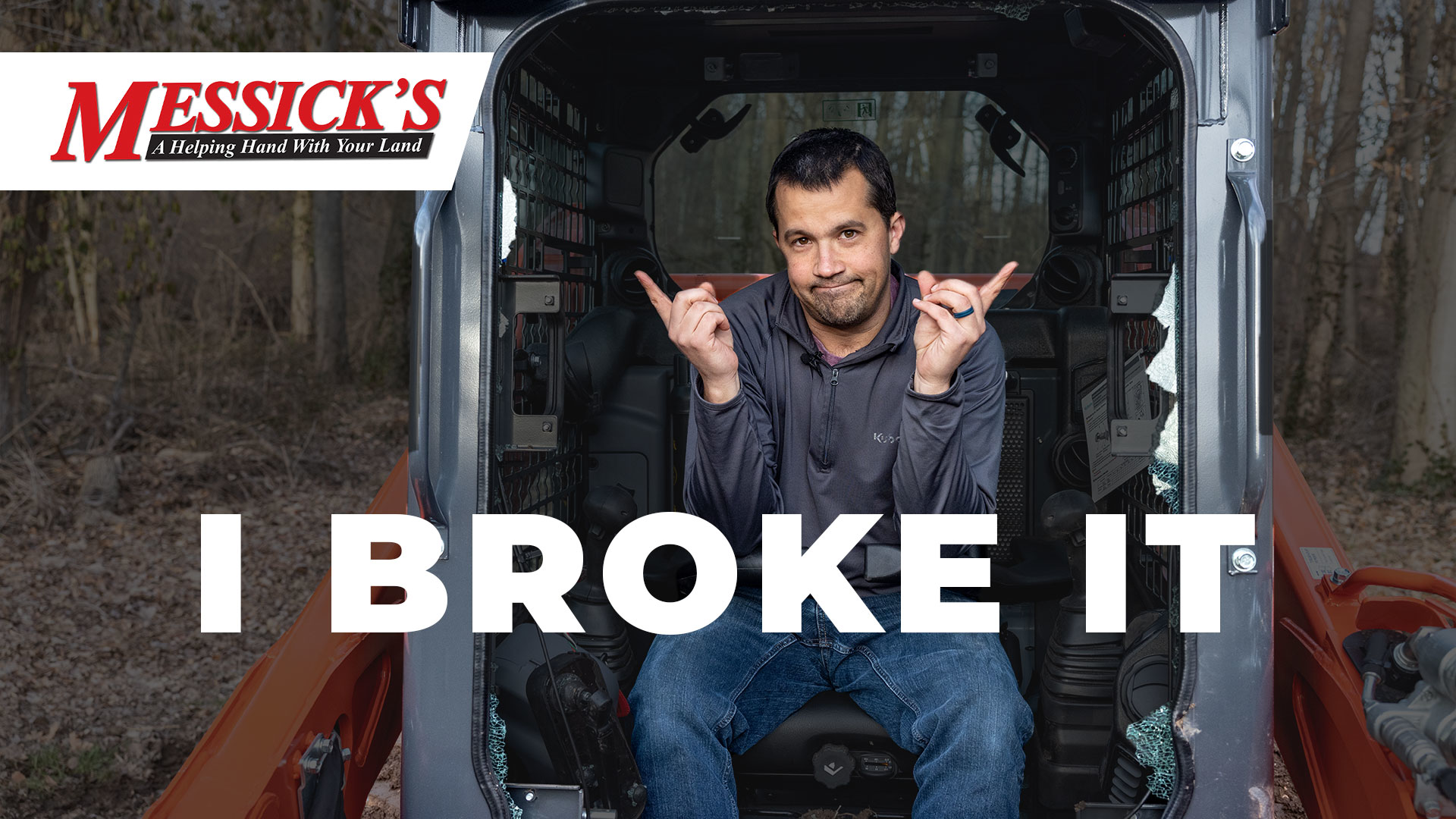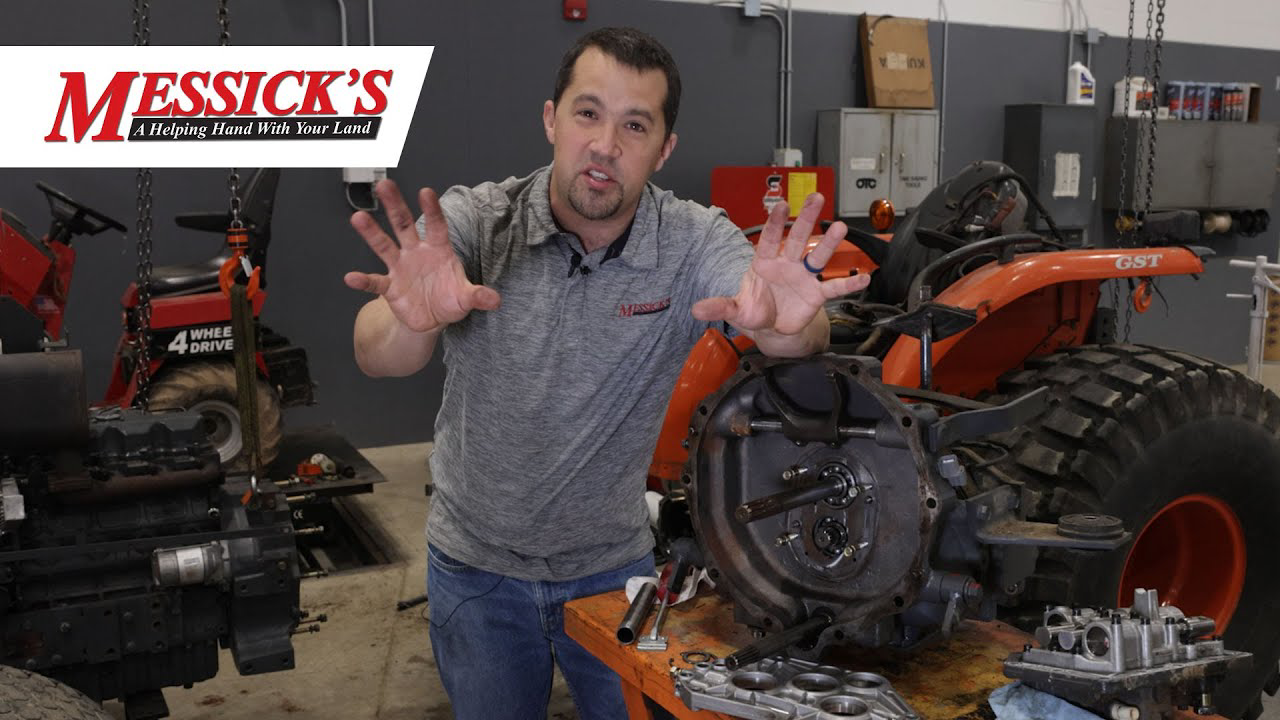Avoiding costly PTO repairs. Clutching before engagement.
Tags : repair |Neil from Messick's here to talk through some of the mechanics in the rear end of your tractor. This machine came into our shop here with some complaints of noise in the rear end coming from the PTO. We're going to show you exactly what parts were in here or why it happened, maybe give you a couple of tips when it comes to operating your tractor that can prevent wear to your PTO driveline.
The tractor that we're working on here today is a Kubota L 4310. This is about a 25-year-old L series tractor. Interestingly enough, this model machine is the very first tractor that I sold when I started working here as a salesman at Messick's that long ago. When this machine came in, it came in for complaints of rattling noises when the PTO is being engaged. Now, how this tractor works, when you turn the PTO on, you've got a yellow lever that sits back here on the right-hand side that's attached to this cable. When you pull that cable, it allows these two pieces to come together and transfer power back here to the back of the tractor. Now, this larger gear right here is actually the shaft that's going back to your PTO. You go through some gear reduction here as that power is passed to the back of the tractor.
These two pieces here are the dogs that are coming together in order to engage, to pass that power to the back. Now, when you look at these two pieces, you'll notice there's no clutch plates in here. There's a spring back here that allows us to come forward and uses that spring pressure to push these together. In the event that these two pieces come together in a way that they slip, over time, that slipping mechanism is going to wear away this edge here on this piece. As this thing turns and it comes together under power, these two pieces are no longer going to bite and it's going to slip. That slip creates a banging noise on the inside of the transmission when the customer is trying to engage this tractor. Now, interestingly enough, this is an area, this machine that Kubota improved over the years.
As these things have aged and we've seen this part start to wear, and a new part is released. In this one, these teeth now are now beveled in a little bit in order to help this part bite a little bit harder. Interesting to see these companies pay attention to how these machines wear out in the field and periodically you get an improved part and that has happened here. I'm going to show the parts here in a little bit more detail. Normally, these are going to sit here in the tractor like this. When disengaged, this one here in this hand is going to be drawn open. When engaged, spring pressure is used to bring these together. Now, you can see here what's happened. As these come together we get that little slipping action right here that's weared away this surface.
Now, what you're going to want to do as the operator of this machine to keep this from happening is to bring these together, not say, spinning. If you don't use the clutch when this tractor comes together and you can do that, If you engage this PTO without the clutch, it does engage. When these parts are brand new, you'll get a hard clunk, but you won't get a grinding noise necessarily. Now, if you use the clutch and you allow this part to slow down inside of the transmission, when these two pieces come together, they're going to come together a lot more gently and hopefully prevent this wear from occurring. On your left here is the improved part. Now, this one we had in stock, this one, we're still waiting to come in. You can see how the beveling changes here a little bit on these new and improved pieces.
You can see how this side right here is cut up just a little bit. As these come together, they're not as apt to slide apart. Another thing that's interesting to see right here is if you've heard of an overrunning clutch on a PTO, this also does your overrunning clutch function. If the PTO shaft, if your implement has momentum and you disengage your PTO and the implement is driving the gearing back into the tractor, it's transmitting that power in reverse, this thing is spinning backwards, opens up the clutch right here and allows the PTO to overrun. You see how these pieces just open up and can spin here. Now you'll hear a clunk, clunk, clunk when this happens, but this function right here is both your clutch to engage the power to the PTO and also the reverse opening up when that overrunning clutch kicks in.
While we're in here, there's a bunch of other interesting parts I can show you. The power from the engine going to the back of the tractor. We'll come through this shaft here on the left-hand side. The hydrostatic motor for your hydrostatic transmission is actually up here in front of this. This is where the power comes through the hydrostatic towards the back and then we'll go into the range selector in the back of the tractor. At that point, it goes through the gearing there that turns the rear wheels and turns around, and comes back to the front again.
This shaft here on the bottom is what's going to turn your front tires when your four-wheel drive is enabled. We've been talking here about the PTO. That PTO power sits over here on the right-hand side of this gear casing. This piece is going to sit in here on this spinning shaft on this spring under pressure. Turning this cable here allows this piece to come front and back on this shaft and that's what's going to engage your PTO when you pull that little red lever. Another thing you'll notice on the inside of this gear case is this, the inside of the transmission strainer. Now, if you follow your maintenance schedules, there's hour intervals where you're supposed to pull this out and clean any debris and stuff off of it. This is a great example here of why these things exist.
As these pieces were wearing together and metal was flaking off of it, this transmission strainer would catch those flakes before they get sucked around and over through the main hydraulic filter. Those things are never getting captured by the filter. The bigger chips are going to sit in the bottom of the transmission housing here and this screen is going to pick them up. Now, you can get some of those chips out of your tractor by pulling that screen out and cleaning it. You can guess the big transmission housing like this when you have a failure like this, that you've got stuff in the bottom of it, splitting the tractor apart like this is really the only way you're actually going to get the inside of a transmission case clean. There's some takeaways from today.
When you hear noises coming from your tractor, if things are banging around, if they're grinding, when you're pulling levers, those are metal parts smacking against each other, bathed in fluid that dampens the noise a little bit, but that's bad stuff happening a lot of times. If there are things that you can do like slowing your tractor down when you make range changes or holding that clutch pedal down when you go to engage your PTO, you're going to improve the lifespan of your tractor. You're going to prevent some of this unseen wear from happening as you're operating your machine. Also, cool to me that the manufacturers pay attention to this stuff. This tractor now after this repair, comes out of here with improved parts on it.
Would have been great if they would have caught it on the front side but we're all people and these things don't turn up for 25 years. Cool to see that this stuff gets improved as time goes on. Newer tractors get more reliable as they're equipped with these updated and more modern parts. Hopefully, we have a good tractor that we can send out to the field here again for years of additional use. Shopping for a piece of equipment if we can help, if you got parts needs, if you're tearing a tractor apart or if you've got service work that you would like us to do, pretty cool what these guys can accomplish out here in the shop, we're glad to help you out. You can give us a call at 800-222-3373 or check us out at Messick's.com.
More Articles

While splitting wood with the Bauma Light wood splitter, I broke the front glass of the Kubtoa SSV. Fortunately, Kubota's design makes this an easy part to replace.

Take a look inside a Kubota L3940 with us to explain a common failure point you should be aware of.










